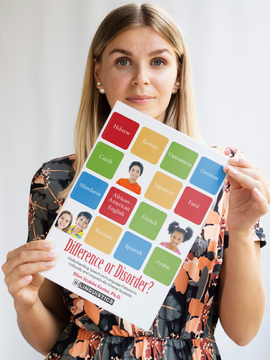Are His Errors Due to Native Language Influence?
$15.00

Course Type: Video – 1 hour
ASHA Course Code: Diversity, Equity, and Inclusion in Education, Training, Service Delivery, Public Policy – 7030
Taking into account speech language development and culture, we aim to provide educators with a solid framework to support your understanding of speech and language patterns in English Language Learners. By understanding the basic structures and typical developmental trajectory of a language, you can better identify which errors are due to language influence, versus those that indicate a true impairment.
We explore Spanish, Russian, Vietnamese, and other languages to help SLPs support English Language Learners.
Additional Information
| Population | School Age |
|---|---|
| Topics | Articulation/Phonology, Diversity, Equity, & Inclusion (DEI), Exp/Rec Language |
| Duration | 1 hour |
| Credit | .1 Continuing Education Unit |
| Format | Video |
Financial Disclosure: Ellen Kester, Ph.D., CCC-SLP. Dr. Ellen Kester is the owner of Bilinguistics and receives a salary. Bilinguistics receives royalty payments for online courses. Non-Financial Disclosure: Ellen Kester does not have any non-financial relationships to disclose.
Financial Disclosure: Phuong Lien Palafox, M.S., CCC-SLP was an employee of Bilinguistics. Bilinguistics receives royalty payments for online courses. Non-Financial Disclosure: Phuong Lien Palafox does not have any non-financial relationships to disclose.
Financial Disclosure: Ladaun Jackson, M.A., CCC-SLP is a former salaried employee of Bilinguistics. Bilinguistics receives royalty payments for online courses.
Non-Financial Disclosure Ladaun Jackson does not have any non-financial relationships to disclose.
This course took into account speech, language and culture to provide educators with a solid framework to support their understanding of speech and language development in English Language Learners. The course also provided information about many languages, including Spanish, Russian and Vietnamese to help Speech-Language Pathologists (SLPs) support English Language Learners.
Participants will be able to:
Utilize a Language Interaction Framework to enhance understanding of speech and language patterns in English Language Learners.
Apply the Language Interaction Framework to many languages.
Identify characteristics consistent with language development in English language learners.
Analyze and interpret results from language samples of English language learners.
Describe expected versus unexpected errors.
Time-Ordered Agenda:
05 minutes: Introduction
10 minutes: Introduction to the Language Interaction Framework
15 minutes: Application of the Language Interaction Framework to different languages.
10 minutes: Characteristics of English language learners
15 minutes: Analysis and interpretation of language samples of English language learners
05 minutes: Summary
Need CEUs?

 Share
Share
 Tweet
Tweet
 LinkedIn
LinkedIn
 Pin
Pin
 Email
Email







